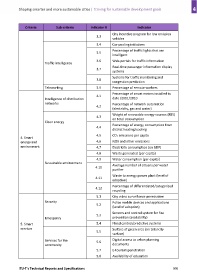Page 915 - Shaping smarter and more sustainable cities - Striving for sustainable development goals
P. 915
Criteria Sub‐criteria Indicator # Indicator
City incentive program for low emission
3.3
vehicles
3.4 Car‐pooling initiatives
Percentage of traffic lights that are
3.5
intelligent
3.6 Web‐portals for traffic information
Traffic intelligence
Real‐time passenger information display
3.7
systems
Systems for traffic monitoring and
3.8
congestion prediction
Teleworking 3.9 Percentage of remote workers
Percentage of smart meters installed to
4.1
Intelligence of distribution date /2011/2010
networks Percentage of network automation
4.2
(electricity, gas and water)
Weight of renewable energy sources (RES)
4.3
on total consumption
Clean energy
Percentage of energy consumption from
4.4
district heating/cooling
4.5 CO2 emissions per capita
4. Smart
energy and 4.6 NOX and other emissions
environment 4.7 Electricity consumption (on GDP)
4.8 Waste generated (per capita)
4.9 Water consumption (per capita)
Sustainable environment
Average number of citizens per water
4.10
purifier
Waste to energy power plant (level of
4.11
adoption)
Percentage of differentiated/categorized
4.12
recycling
5.1 City video surveillance penetration
Security Police mobile devices and applications
5.2
(level of adoption)
Sensors and control system for fire
5.3
Emergency prevention (availability)
5. Smart 5.4 Flood control/predictive systems
services Surface of green area (on total city
5.5
surface)
Services for the Digital access to urban planning
5.6
community documents
5.7 E‐tourism penetration
5.8 Availability of education
ITU‐T's Technical Reports and Specifications 905

